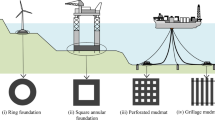Abstract
Naturally deposited soils are always found in the complex three-dimensional stress state. Constitutive models developed for modeling the three-dimensional mechanical behavior of soils should obey the basic laws of thermo-mechanical principles. Based on the incremental dissipation function, a new deviatoric shift stress is derived and then introduced into the existing constitutive models to describe the yield behavior in the deviatoric plane for geomaterials. By adopting the proposed shift stress, the relationship between dissipative stress tensors and true stress tensors can be established. Therefore, the three-dimensional plastic strain can be calculated reasonably through the associated flow rule in the three-dimensional dissipative stress space. At the same time, three methods that are conventionally adopted for generalizing constitutive models to model the three-dimensional stress-strain relationships are examined under the thermo-mechanical framework. The TS (transformed stress) method is shown to obey the thermo-mechanical rules and the TS space adopted in TS method is actually a translational three-dimensional dissipative stress space. However, it is illustrated that the other two approaches, the method of using failure criterion directly and the method of using g(θ) function, violate the basic rules of thermo-mechanical theories although they may bring convenience and simplicity to numerical analysis for geotechnical engineering. Comparison between model predictions and experimental data confirms the validity of the proposed three-dimensional dissipative stress space.
Similar content being viewed by others
References
Houlsby G T, Puzrin A M. A thermomechanical framework for constitutive models for rate-independent dissipative materials. Int J Plasticity, 2000, 16: 1017–1047
Collins I F, Houlsby G T. Application of thermomechanical principles to the modeling of geotechnical materials. Proc Roy Soc Lond A, 1997, 453: 1975–2001
Houlsby G T, Puzrin A M. Principles of Hyperplasticity. London: Springer. 2007, 53–76
Collins I F. Elastic/plastic models for soils and sands. Int J Mech Sci, 2005, 47: 493–508
Collins I F, Hilder T. A theoretical framework for constructing elastic/plastic constitutive models of triaxial tests. Int J Numer Anal Met, 2002, 26: 1313–1347
Collins I F, Kelly P A. A thermomechanical analysis of a family of soil models. Geotechnique, 2002, 52: 507–518
Roscoe K H, Burland, J B. On the generalized stress-strain behaviour of ‘wet clay’. In: Engineering plasticity. Cambridge: Cambridge University Press, 1968. 535–609
Roscoe K H, Schofield A N, Thurairajah A. Yielding of clays in state wetter than critical. Geotechnique, 1963, 13: 21–40
Arthur J R F, Chua K S, Dunstan T. Induced anisotropy in a sand. Geotechnique, 1977, 27: 13–30
Matsuoka H, Nakai T. Stress-deformation and strength characteristics of soils under three different principal stresses. In: Proc JSCE. 1974: 232: 59–70
Lade P V, Duncan J M. Elasto-plastic stress-strain theory for cohesionless soils with curved yield surface. Int J Solids Struct, 1977, 13: 1019–1035
Yao Y P, Lu D C, Zhou A N, et al. Generalised non-linear strength theory and transformed stress space. Sci China Ser-E Tech Sci, 2004, 47: 691–709
Argyris J H, Faust F, Szimat J, et al. Recent developments in finite element analyses of prestressed concrete reactor vessels. Nucl Eng Des, 1974, 28: 42–75
Matsuoka H, Yao Y P, Sun D A. The Cam-clay models revised by the SMP criterion. Soils Found, 1999, 39: 81–95
Yao Y P, Sun D A. Application of Lade’s criterion to Cam-clay model. J Eng Mech-ASCE, 2000, 126: 112–119
Yao Y P, Zhou A N, Lu D C. Extended transformed stress space for geomaterials and its application. J Eng Mech-ASCE, 2007, 133: 1115–1123
Collins I F. The concept of stored plastic work or frozen elastic energy in soil mechanics. Geotechnique, 2005, 55: 373–382
Collins I F, Muhunthan B. On the relationship between stress-dilatancy, anisotropy, and plastic dissipation for granular materials. Geotechnique, 2003, 53: 611–618
Collins I F. A systematic procedure for constructing critical state models in three dimensions. Int J Solids Struct, 2003, 40: 4379–4397
Nakai T, Matsuoka H, Okuno N, et al. True triaxial tests on mormally consolidated clay and analysis of the observed shear behaviour using elastoplastic constitutive models. Soils Found, 1986, 26: 67–78
Yao Y P, Hou W, Zhou A N. Constitutive model for overconsolidated clays. Sci China Ser E-Tech Sci, 2008, 51: 179–191
Yao Y P, Yang Y F, Niu L. UH model considering temperature effects. Sci China Tech Sci, 2011, 54: 190–202
Yao Y P, Kong L M, Hu J. An elastic-viscous-plastic model for over-consolidated clays. Sci China Tech Sci, 2013, 56: 441–457
Luo T, Yao Y P, Chu J. Asymptotic state behaviour and its modeling for saturated sand. Sci China Tech Sci, 2009, 52: 2350–2358
Author information
Authors and Affiliations
Corresponding author
Rights and permissions
About this article
Cite this article
Yao, Y., Cui, W. & Wang, N. Three-dimensional dissipative stress space considering yield behavior in deviatoric plane. Sci. China Technol. Sci. 56, 1999–2009 (2013). https://doi.org/10.1007/s11431-013-5281-7
Received:
Accepted:
Published:
Issue Date:
DOI: https://doi.org/10.1007/s11431-013-5281-7




